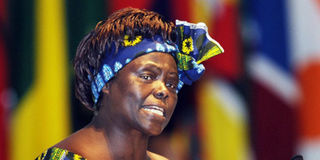When Moi asked Wangari Maathai to ‘respect men, be quiet’

The late Nobel Peace laureate Prof Wangari Maathai. In her memoir, Unbowed: One Woman’s Story, Wangari states that encroachment on Uhuru Park had been an eyesore since Independence.
What you need to know:
- In her memoir, Unbowed: One Woman’s Story, Wangari states that encroachment on Uhuru Park had been an eyesore since Independence.
- Moi’s 10-year anniversary monument was built at the intersection of Uhuru Highway and Kenyatta Avenue.
In 1989, Prof Wangari Maathai was working late in her office. A law student abruptly visited and astounded her with information that Uhuru Park was on the verge of being grabbed.
The park was Nairobi’s equivalent of London’s Hyde Park and New York’s Central Park. The intrusion was to pave the way for construction of a skyscraper, which was to be called Times Media Trust Complex.
In her memoir, Unbowed: One Woman’s Story, Wangari states that encroachment on Uhuru Park had been an eyesore since Independence. Moi’s 10-year anniversary monument was built at the intersection of Uhuru Highway and Kenyatta Avenue.
By 1989, Uhuru Park covered only 34 acres. Despite past infiltration, nothing would have cast a shadow over the park as a 60-floor facility, which would house Kenya Times newspaper, Kanu headquarters, shopping malls, offices and parking space for 2,000 vehicles.
The tower would have been the tallest building in Africa and cost $200 million (about Sh27.2 billion). On October 3, 1989, Wangari wrote a letter, with the Green Belt Movement letterhead, to the managing director of Kenya Times, informing him not to proceed with the project.
She sent copies of the letter to the Office of the President, the United Nations Environment Programme, the Nairobi City commission, the provincial commissioner and the Environment Liaison Centre International.

The cover of Nobel Peace Laureate Wangari Mathai's memoir, Unbowed: One Woman's Story.
Government institutions ignored her appeal, unsurprisingly as she’d historically had tumultuous relations with President Daniel arap Moi. Wangari had worked at the University of Nairobi (UoN) and chaired the Department of Veterinary Anatomy from 1966.
Her extensively publicised and publicly humiliating divorce from Mwangi Maathai was finalised in 1979, turning her into a pariah. She continued with her work in the Green Belt Movement under the auspices of the National Council of Women of Kenya (NCWK).
In that era, educated Kenyans were an isolated minority and were regarded with suspicion. Wangari had returned to Kenya after majoring in biology from Mount St Scholastica, to the North West of Kansas City, as a beneficiary of the 1960 Tom Mboya airlifts.
She furthered her studies at the University of Pittsburgh in Pennsylvania, before pursuing her doctorate at the University of Giessen in Germany. Her academic accolades did not impress the authorities.
Underhand tactics
Moi resorted to underhand tactics, ensuring Maendeleo Ya Wanawake Organisation (MYWO) and Girl Guides group withdrew from the NCWK, the umbrella body where Wangari was the vice chair. Some officials swindled the organisation and left it bankrupt.
Wangari contested the leadership of the NCWK and won, shrugging off opposition from Moi’s autocracy. She was re-elected NCWK chair every subsequent year through 1987, when she retired.
In January 1982, Wangari submitted her official letter of resignation from the UoN. Government officials schemed to bar her from contesting a parliamentary position in Nyeri. Moi was against her ambition. When she requested reinstatement, the UoN rebuffed it.
On October 26, 1989, three weeks after she wrote her first letter on the skyscraper to the authorities, she wrote another letter to the British High Commissioner, Sir John Johnson, urging him to inform Robert Maxwell, the proprietor of London Mirror Group Newspapers and a 45 per cent shareholder of the Kenya Times Complex project, of the environmental consequences of the building.
On November 16, 1989, she wrote to Moi in an appeal of last resort, requesting him to terminate the project and consult his conscience and purported commitment to conservation, which he displayed while burning 100 tonnes of ivory in July 1989.
On December 11, 1989, Wangari’s court case that sought to halt the construction was dismissed. The Executive had a hand in the decision.
The following day, on December 12, 1989, Moi exposed himself as a misogynist. In a speech he delivered during Jamhuri Day celebrations in Uhuru Park, he stated: “Wangari should be a proper traditional African woman, respect men and be quiet.”
The day after the speech, the NCWK and the Green Belt Movement, together with their 80 employees, were ordered out of their premises next to the Nairobi Central Police Station. They had grown 30 million trees since 1977, using a network of rural women.
In 1990, Wangari’s vocal voice led US dailies, New York Times and Los Angeles Times, and Britain’s Independent, to question why foreign investors and donor governments were spending astonishing amounts on the dubious tower project in a country struggling with domestic and international debts.
On January 29, 1980, the government announced that it had dropped the plan. International media reported that after a meeting with the World Bank in London, Kenyan officials appeared disinterested in the tower. In February 1992, Wangari was informed that the fence around Uhuru Park had been sequestered.
The UoN was elated to see Wangari leave in January 1982 and denigrated her from accessing her 16-year benefits. After Wangari was awarded the Nobel Peace Prize in 2004, the university, in a show of regret, awarded her an honorary doctorate in science in 2005.
The reviewer is a novelist, a Big Brother Africa 2 Kenyan representative and founder of Jeff's Fitness Centre (@jeffbigbrother).





